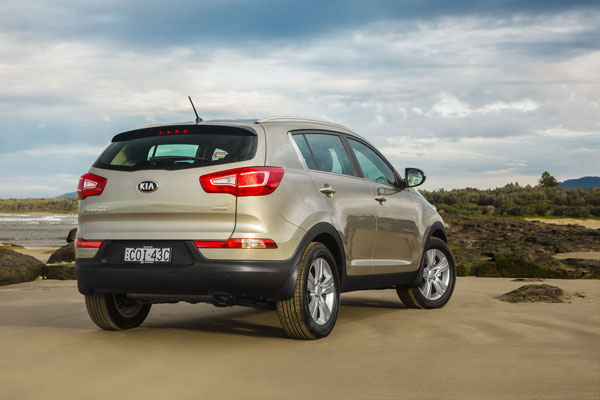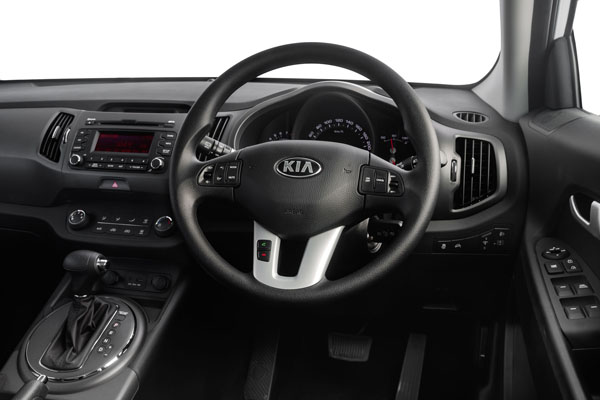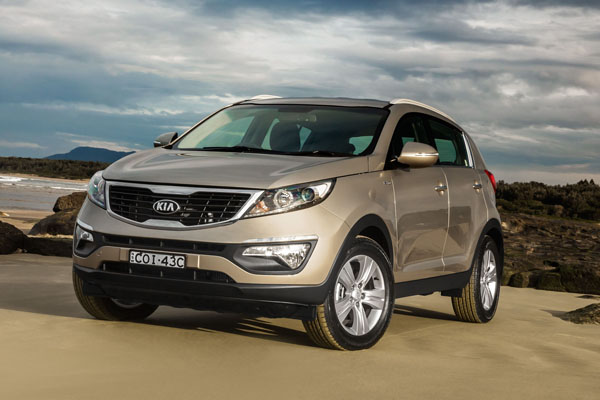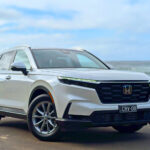Kia Sportage has been something of a late bloomer for the South Korean importer. The smaller of Kia’s two SUVs, it was one of the first models to go on sale here when the company arrived here in 1996, and the only one to have been here continuously since then.
Sales were hampered by Sportage’s rather bland styling until the arrival of the third-generation model in 2010 when Kia’s renowned design chief, Peter Schreyer, transformed it into a much more stylish vehicle, one that is gradually clawing its way up the sales ladder in this most competitive of segments.
Sportage was given a mid-life upgrade in June 2013. External changes with this new Series II model are minor with the addition of HID headlights to the premium model, static cornering lights and foglamps built into the rear reflector cluster. Inside there are new leather seat stitch pattern and colour, revised headrest design, lockable glove box, more soft-touch materials and additional air-conditioning vent modes.

As is the norm nowadays Kia Sportage comes with the choice of two or four wheel drive and petrol or diesel power. There are three equipment levels, Si, SLi and Platinum with prices ranging from $25,490 to $39,990. If you prefer to do your own gear changing then you’re restricted to the entry level Si petrol with six-speed manual. All others come with six-speed automatic transmission.
Interestingly, Sportage Series II is the first ever Kia model to be sourced from Europe, coming out of the company’s factory at Zilina in Slovakia. It will be followed off the same production line early this year by the weirdly-named Pro_Cee’d GT hatch.

The 2010 re-design created a Sportage that was longer, wider and lower than the previous model but did so with compromising either headroom or the high driving position that appeals to SUV buyers. From our previous test of the Platinum model with its panoramic glass roof that extra feature can cause problems for tall occupants.
Our only other criticism is the small rear windscreen that limits rearward visibility. When reversing the problem is reduced in the SLi and Platinum variants which come with a rearview camera that projects either into the left-hand side of the rear-view mirror in the SLi or onto the in-dash screen in the Platinum, or the SLi with the Navigation package.
External vision to the front and sides is excellent courtesy of a wide windscreen and large side mirrors.
Cargo space is right up with the best in the class ranging from 564 litres with the rear seatbacks upright to 1353 litres with them folded. There’s a full size spare wheel under the cargo area floor which makes for a relatively high loading height.
ENGINES / TRANSMISSIONS
Both petrol and diesel engines have a 2.0-litre capacity with the previous 2.4-litre petrol being discontinued. Maximum power is 122 kW from the petrol with the diesel generating up to 135 kW while torque peaks at 197 Nm and 392 Nm respectively.
The six-speed automatic transmission changes smoothly although the ‘Sport’ manual mode is a bit of a misnomer moving softly and slowly between cogs rather than in a hard and fast sporty manner. There are no paddle shifters so manual overrides can only be made via the gear lever.
DRIVING
Our test car was the Kia Sportage SLi with the 2.0-litre diesel engine. Standing outside the vehicle the characteristic diesel rattle is there although once underway it’s barely noticeable. The engine belongs to Kia’s new ‘R’ family of diesels that uses a common-rail system with piezo-electric injectors at high pressure for accurate fuel delivery.
With torque of just under 400 Nm it’s likely to be the preferred choice of most buyers although many will be put off by the $3000 to $3500 surcharge over its petrol equivalent.
Combined cycle fuel consumption from the diesel Sportage is listed at 6.1 litres per 100 kilometres in rural and motorway conditions and 9.1 L/100 km in and around the city. During our test we found ourselves using around the mid-nines.
Australian engineers were involved in optimising Kia Sportage’s ride and handling characteristics for our local conditions, including outback and rough suburban surfaces.
The ride on normal sealed roads is a little on the firm side, which is acceptable for the driver who likes handling and grip which is pretty good for the compact SUV class. On the other hand, those ho prefer comfort may not like it. As always, try before you buy.
We took our Kia Sportage over our favourite local dirt tracks shortly after a wet spell and were always felt confident of the grip on the slippery surface provided by the Kia Dynamax all-wheel drive system.
FEATURES
Standard safety features across the Sportage range include front, side and curtain airbags; Electronic Stability Control; Hill Start Assist; Downhill Brake Control; ABS brakes with Electronic Brakeforce Distribution and Brake Assist; and Emergency Stop Signal.
There’s also a rear spoiler; Included in the upper echelons are LED daytime running lights, ‘welcome home’ light delay, automatic light control, keyless entry, engine start/stop button, and a reversing camera that projects an image onto the left-hand third of the interior mirror, enabling the driver to get a real-world rear view without glancing away from the mirror.
Other standard features in the entry-level Si are relatively sparse but include a rear spoiler; cruise control; auxiliary and USB sockets; Bluetooth phone and audio streaming; and speed dependent audio volume control. In addition to all-wheel drive the SLi models add reverse parking sensors; rear-view camera; LED daytime running lights; roof rails; cooling glovebox; and dual-zone climate control air conditioning.
Sportage Platinum adds satellite navigation; 7-inch LCD touch screen; push button start; leather trim seats; panoramic sunroof; enhanced audio and front and rear seat warmers
SUMMING UP
Kia Sportage has always been a sensible and affordable small-medium SUV that had been let down by its uninspiring looks. European design work added style to its substance and now, with production also coming from the Continent, where some excellent negotiating by Kia Australia has led to price cuts of up to $1500, there are plenty of reasons to add Sportage to your SUV shopping list.
AT A GLANCE
Si 2WD 2.0-litre petrol five-door wagon: $25,490 (manual), $27,490 (automatic)
SLi 4WD 2.0-litre petrol five-door wagon: $31,990 (automatic)
SLi 4WD 2.0-litre turbo-diesel five-door wagon: $35,490 (automatic)
Platinum 4WD 2.0-litre petrol five-door wagon: $36,490 (automatic)
Platinum 2.0-litre turbo-diesel five-door wagon: $39,990 (automatic)
Note: Prices do not include government or dealer charges. Contact your local Kia dealer for driveaway pricing.
FEATURES
ABS Brakes: Standard in all models
Automatic Transmission: Optional in SL; standard in SLi and Platinum
Cruise Control: Standard in all models
Dual Front Airbags: Standard in all models
Front Side Airbags: Standard in all models
Electronic Stability Program: Standard in all models
Rear Parking Sensors: Standard in all models
Reversing Camera: Not offered in SL, optional in SLi, standard in Platinum
USB/Auxiliary Audio Inputs: Standard in all models
Bluetooth: Standard in all models (phone and audio streaming)
Steering Wheel Mounted Controls: Standard in all models
SPECIFICATIONS (Kia Sportage SLi 4WD 2.0-litre turbo-diesel five-door wagon
ENGINE:
Capacity: 1.995 litres
Configuration: Four cylinders in line
Bore and Stroke: 84.0 x 90.0 mm
Compression Ratio: 16.0:1
Maximum Power: 135 kW @ 4000 rpm
Maximum Torque: 392 Nm @ 1800-2500 rpm
DRIVELINE:
Driven Wheels: AWD
Manual Transmission: Not offered in SLi
Automatic Transmission: Six speed
Final Drive Ratio: 3.041:1
DIMENSIONS, WEIGHT AND CAPACITIES:
Length: 4440 mm
Wheelbase: 2640 mm
Width: 1855 mm (excluding door mirrors)
Height: 1635 mm (without roof rails), 1645 mm (with roof rails)
Track: 1614 mm (front); 1615 mm (back)
Overhang: 890 mm (front); 910 mm (rear)
Minimum Ground Clearance: 172 mm
Turning Circle: 10.58 metres
Kerb Mass: 1609 kg
Fuel Tank Capacity: 55 litres
Towing Ability: 750 kg (1600 kg with braked trailer)
Boot Capacity: 564 litres (1353 litres with rear seats folded)
SUSPENSION AND BRAKES
Front Suspension: Independent, MacPherson struts, coil springs, gas-filled shock absorbers and anti-roll bar
Rear Suspension: Independent, multi-link, coil springs, gas-filled shock absorbers
Front Brakes: Ventilated disc
Rear Brakes: Solid disc
FUEL CONSUMPTION:
Type: 91 RON
Combined Cycle (ADR 81/01): 7.5 litres/100km, CO2 emissions: 198g/km
GREEN VEHICLE GUIDE RATINGS:
Greenhouse Rating: 6.5/10
Air Pollution Rating: 5/10
STANDARD WARRANTY:
Five years/unlimited km












